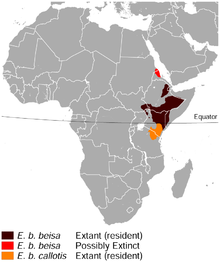This article needs additional citations for
verification. (July 2017) |
| Common beisa oryx | |
|---|---|

| |
|
Scientific classification
| |
| Domain: | Eukaryota |
| Kingdom: | Animalia |
| Phylum: | Chordata |
| Class: | Mammalia |
| Order: | Artiodactyla |
| Family: | Bovidae |
| Subfamily: | Hippotraginae |
| Genus: | Oryx |
| Species: | |
| Subspecies: | O. b. beisa
|
| Trinomial name | |
| Oryx beisa beisa (
Rüppell, 1835)
| |

| |
| Fringe-eared and common beisa oryx ranges [1] | |
The common beisa oryx (Oryx beisa beisa), also known as the beisa oryx, is the nominate subspecies of the East African oryx native to the Horn of Africa and Kenya. It is closely related to the fringe-eared oryx. There are four species of oryx, one of which has two distinct subspecies. Although they are very similar in appearance, they have a number of distinct characteristics that allow identification. Common beisa oryx have fringed ears and black tufts of hair that extend past their ears. However, all species of oryx are compact and muscular, with relative long bodies and broad necks. There are not any marked difference between male and female oryx. The common beisa oryx enjoys feeding on a variety of grass species. They feed during the day, when the plants hold the most water. During the dry season, they feed on poisonous Adenium plants.
Habitat
The common beisa oryx once inhabited a large region of northeastern Africa, from Sudan down to Tanzania, but it has been going extinct rapidly. Now they mostly remain in Ethiopia and northern Kenya. In 1959, a boundary change in the Serengeti National Park excluded the area inhabited by the common beisa oryx. Recent observations (1974–1975) show that oryx are still only visitors to the Serengeti National Park, but there are indications that they may become resident in the future. [2] Common beisa oryx stay in bushland and grassland areas. During the wet season, they move to high ground and avoid tall grass and saturated areas. They move great distances to find a perfect location and stay there for a few seasons.
References
- ^ IUCN (International Union for Conservation of Nature) 2008. Oryx beisa. In: IUCN 2015. The IUCN Red List of Threatened Species. Version 2015.2. "The IUCN Red List of Threatened Species". Archived from the original on 27 June 2014. Retrieved 2014-06-27.. Downloaded on 14 July 2015.
- ^ Walther, F. R. (1978-05-30). "Behavioral Observations on Oryx Antelope (Oryx beisa) Invading Serengeti National Park, Tanzania". Journal of Mammalogy. 59 (2): 243–260. doi: 10.2307/1379910. ISSN 1545-1542. JSTOR 1379910.
- ^ “Beisa Oryx.” Beisa Oryx | MpalaLive, mpalalive.org/field_guide/beisa_oryx.
- ^ SloaneCommunications, Lulu. “Aerial Surveys Highlight Beisa Oryx Hotspot.” Fauna & Flora International, Fauna & Flora International , 20 Feb. 2018, https://www.fauna-flora.org/news/aerial-surveys-highlight-beisa-oryx-hotspot.
